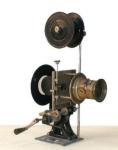 Menu
Menu
|
Function To study the reflection laws. |

| ||
|
|||
|
Description The apparatus is made in varnished metal. The index turns on the axe of the half-cylinder. The mirror, joined to the index, reflects the light that comes from a slit. | |||
|
Function To study the refraction laws. |

| ||
|
|||
|
Description A half-cylinder container in varnished metal. A slit for the light is placed on the plane wall. A scale to measure the refraction angle is placed inside the curved surface. | |||
|
Function To show that white light can be obtained as the sum of the rainbow colours. |

| ||
|
|||
|
Description The disk is formed of various sectors painted with the rainbow colours. It is used with the rotating machine. Because of the persistence of the image on the retina, the various colours superimpose giving the sensation of the white. | |||
|
Function To study the light polarisation. |

| ||
|
|||
|
Description It is the easiest polarisation apparatus. It is made of two tourmaline plates, that were cut parallelly to the optics axis of the tourmaline crystal. They are fixed in disk-shaped supports which are turning in the handle. A ray that strikes one of the two plates (polariser) is refracted twice; the ordinary ray is absorbed by the plate, while the extraordinary ray appears more or less coloured (green, brown, red) according to the tourmaline. The second plate is used as analyser; when the tourmalines are crossed the field appears dark. When the tourmalines are parallel the field is bright. The polariser and analiser can be exchanged at will: the fact does not change. | |||
|
Function To learn the use of the microscope. |

| ||
|
|||
|
Description The instrument, in brass, is formed by two converging lenses, one called “eyepiece” on which the observer poses his eye. The other lens is the objective, directed towards the object to be observed. We can change the distance between the two lenses until we obtain a clear image. The objective is formed by a converging lens with a smoll focal distance and for this it produces an inverted, reduced and real image. If this image is formed at a shorter distance from the focal distance of the eyepiece, we obtain a right-side up, magnified and virtual image. The image is inverted compared to the object. It is demountable and is given with a wooden case. | |||
|
Function To study the camera obscura. |

| ||
|
|||
|
Description It is made with wood and cloth. | |||
|
Function Stereoscopic view of photos of the First World War. |

| ||
|
|||
|
Description This model is of the type with a chain, a conveyor belt and a changeable belt bearer. The format of the photos is 16 x 13. This small piece of furniture is in polished plywood with two eyepieces with a longitudinal shift, a lamp-holder that has the form of a bookstall and a plug for the current socket. | |||
|
Function For projecting animated pictures. |

| ||
|
|||
|
Description This cinematograph can be fixed in front of any existing optical lantern. | |||
 Menu
Menu
|
Function To show the electric charge in very rarefied air. |

| ||
|
|||
|
Description They are made on fluorescent glace and hold very rarefied air. These tubes of different shapes and sizes are provided with ring joints with aluminium electrodes. | |||